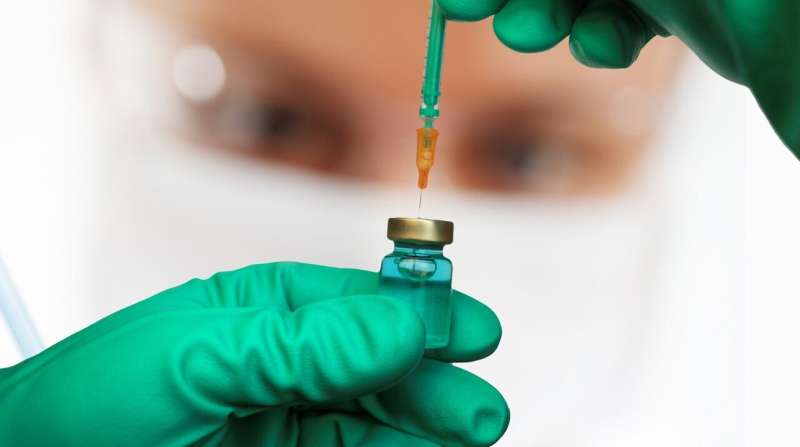India, Pakistan fight child vaccination backslide


India and other South Asian countries must deal with a dangerous backslide in routine infant vaccinations during 2019–2021 brought on by the COVID-19 pandemic and restrictions imposed to counter its spread, say UNICEF officials.
“Immunization coverage has fallen for nearly all vaccines in the routine schedule between 2019 and 2021,” Rene Ekpini, regional advisor for health at the United Nations Children’s Fund (UNICEF) South Asia told SciDev.Net.
Across the world, some 25 million children missed out on one or more doses of the combined diphtheria-tetanus-pertussis (DTP3) vaccine, according to data released in July by the World Health Organization and UNICEF. “Of the children who missed out, five million were from South Asia,” said Ekpini.
Diphtheria, tetanus and pertussis are serious bacterial infections that can be prevented in children with the combined DPT vaccine that has been part of universal immunization programs since 1948.
According to the UNICEF/WHO data, 3.4 million of the unvaccinated or under-vaccinated children were from India. The country also accounted for 15% of all children who did not receive even a single dose of the DTP3 vaccine—considered a marker for immunization coverage.
Ekpini said that the impact of the drop in coverage would be different and dependent on the contagiousness of a particular disease. “A five percentage point drop in measles coverage may not sound high, but because of its extreme contagiousness it can affect all children who lack protection against it, resulting in large outbreaks,” he said.
Inadequate coverage has already resulted in outbreaks of measles and polio over the past 12 months, underscoring the need to immunize children, adolescents and adults against preventable diseases and keep societies healthy, Ekpini said.
While vaccine coverage dropped in every region, the East Asia and Pacific region recorded the steepest reversal in DTP3 coverage, falling by nine percentage points in two years, with the highest numbers coming from India, Pakistan, the Philippines and Indonesia, according to UNICEF/WHO.
Globally, DTP3 coverage was set back to its lowest level since 2008 which, along with declines in coverage for other basic vaccines, pushed the world off-track to meet global goals, including the immunization indicator for the UN’s Sustainable Development Goals.
The decline was attributed to several factors, including increased misinformation, COVID-19 related issues such as service and supply chain disruptions, resource diversion to pandemic response efforts, and containment measures that limited immunization service access and availability.
“This historic backsliding in rates of immunization is happening against a backdrop of rapidly rising rates of severe acute malnutrition. A malnourished child already has weakened immunity and missed vaccinations can mean common childhood illnesses quickly become lethal to them,” a UNICEF/WHO statement said.
While India and Pakistan topped the list of countries that saw the greatest increase in children not receiving a first dose of DTP between 2019 and 2020, they were also quick to bounce back.
Pakistan now figures among countries that successfully fought back declines to return to pre-pandemic levels of coverage “thanks to high-level government commitment and significant catch-up immunization efforts,” UNICEF/WHO said.
In India, progress towards reducing the number of zero-dose children was impacted by the pandemic and the number of children who did not receive the first dose of the DTP vaccine was estimated to have increased to three million in 2020, up from 1.4 million in 2019, according to Mainak Chatterjee, health specialist at UNICEF India.
“Despite having the largest birth cohort in the world, India was able to prevent a further backslide through special drives such as the Intensified Mission Indradhanush, which enabled the country to bring down zero-dose to 2.7 million in 2021,” Chatterjee told SciDev.Net.
In February, the government launched what it described as “the largest vaccination drive globally,” reaching out to missed children and pregnant women. India already vaccinates more than 30 million pregnant women and 26 million children through its Universal Immunization Program.
India not only managed to prevent a decline in routine coverage, it also ensured continued focus on COVID-19 vaccination, said Chatterjee. “A rapid resumption of routine immunization services coupled with evidence-based catch-up campaigns enabled India to limit the backslide,” he said.
“Unvaccinated or ‘zero-dose’ children tend to live in the most vulnerable communities within countries and they suffer the most when hurdles to vaccination increase—the number of zero-dose children was actually found [to be] higher than the number who had received partial vaccination,” Ekpini said.
Source: Read Full Article